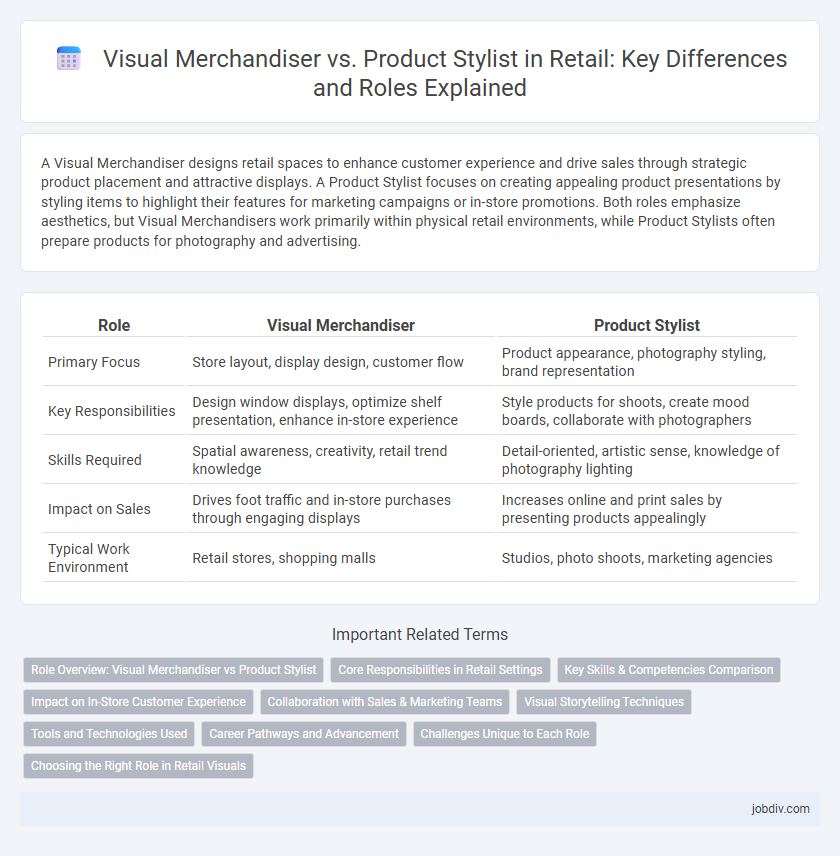A Visual Merchandiser designs retail spaces to enhance customer experience and drive sales through strategic product placement and attractive displays. A Product Stylist focuses on creating appealing product presentations by styling items to highlight their features for marketing campaigns or in-store promotions. Both roles emphasize aesthetics, but Visual Merchandisers work primarily within physical retail environments, while Product Stylists often prepare products for photography and advertising.
Table of Comparison
| Role | Visual Merchandiser | Product Stylist |
|---|---|---|
| Primary Focus | Store layout, display design, customer flow | Product appearance, photography styling, brand representation |
| Key Responsibilities | Design window displays, optimize shelf presentation, enhance in-store experience | Style products for shoots, create mood boards, collaborate with photographers |
| Skills Required | Spatial awareness, creativity, retail trend knowledge | Detail-oriented, artistic sense, knowledge of photography lighting |
| Impact on Sales | Drives foot traffic and in-store purchases through engaging displays | Increases online and print sales by presenting products appealingly |
| Typical Work Environment | Retail stores, shopping malls | Studios, photo shoots, marketing agencies |
Role Overview: Visual Merchandiser vs Product Stylist
Visual Merchandisers focus on creating appealing in-store displays that enhance the customer shopping experience and drive sales by strategically arranging products and designing layouts. Product Stylists specialize in curating and arranging products for photo shoots, advertising campaigns, and online presentations to highlight the lifestyle and aesthetic appeal of merchandise. Both roles require a strong sense of design and consumer behavior but differ in their primary environments and objectives--Visual Merchandisers optimize physical retail spaces, while Product Stylists craft visual narratives for marketing materials.
Core Responsibilities in Retail Settings
Visual Merchandisers specialize in designing store layouts, window displays, and in-store signage to enhance customer experience and drive sales. Product Stylists focus on arranging and presenting individual products, ensuring they look appealing in photoshoots or promotional materials. Both roles collaborate closely to maintain brand aesthetics, but Visual Merchandisers prioritize spatial organization while Product Stylists emphasize detailed product presentation.
Key Skills & Competencies Comparison
Visual merchandisers excel in spatial design, understanding consumer behavior, and brand consistency to create engaging retail displays that drive sales. Product stylists specialize in product presentation, lighting techniques, and aesthetic coordination to enhance the appeal of individual items in photography and advertising. Both roles require creativity, keen attention to detail, and collaboration skills, but visual merchandisers focus more on in-store environments while product stylists prioritize visual storytelling through imagery.
Impact on In-Store Customer Experience
Visual Merchandisers design store layouts and displays to maximize customer engagement, using spatial arrangement and lighting to highlight products effectively. Product Stylists focus on creating appealing product groupings and aesthetics that tell a compelling brand story, enhancing the emotional connection with shoppers. Together, their efforts improve in-store customer experience by increasing product visibility and inspiring purchase decisions through strategic presentation.
Collaboration with Sales & Marketing Teams
Visual Merchandisers collaborate closely with sales and marketing teams to design store layouts and displays that enhance product visibility and drive customer engagement, leveraging data insights to boost conversions. Product Stylists work alongside marketing professionals to create appealing, trend-driven product presentations for advertising campaigns, ensuring visual coherence across digital and print media. Both roles synchronize efforts to align merchandising strategies with brand messaging and sales objectives, maximizing overall retail performance.
Visual Storytelling Techniques
Visual merchandisers utilize spatial design and lighting techniques to create immersive retail environments that enhance brand identity and drive customer engagement through visual storytelling. Product stylists focus on meticulously arranging merchandise and props to highlight product features and evoke emotional connections, often tailoring scenes for photography or advertising. Both roles employ complementary visual storytelling methods to captivate audiences and boost sales, with merchandisers shaping in-store experiences and stylists refining product presentation.
Tools and Technologies Used
Visual Merchandisers utilize space-planning software, 3D design tools, and digital signage platforms to create engaging in-store displays that drive customer traffic. Product Stylists depend on high-resolution imaging cameras, photo editing software, and lighting equipment to enhance product presentation for catalogs and online listings. Both roles embrace augmented reality (AR) and virtual reality (VR) technologies to visualize product placement and styling in retail environments effectively.
Career Pathways and Advancement
Visual merchandisers often progress from entry-level roles such as retail associate to positions like visual merchandising manager, emphasizing skills in store layout design and brand consistency. Product stylists typically advance through experience in fashion or product photography, moving toward senior stylist or creative director roles that focus on visual storytelling and product presentation. Both career paths offer opportunities for specialization, leadership, and collaboration with marketing teams to enhance consumer engagement and sales.
Challenges Unique to Each Role
Visual merchandisers face challenges such as optimizing store layouts to enhance customer flow and increase sales while maintaining brand consistency across multiple locations. Product stylists contend with creating appealing product presentations that resonate with target audiences within often tight timeframes and limited budgets. Both roles require balancing creativity with strategic marketing goals, but visual merchandisers concentrate on spatial design, whereas product stylists focus on aesthetic product arrangement.
Choosing the Right Role in Retail Visuals
Visual Merchandisers focus on designing retail spaces to enhance customer experience and drive sales by strategically arranging products, signage, and displays based on shopper behavior analytics. Product Stylists specialize in creating appealing product presentations for advertising, catalogues, and online platforms, emphasizing aesthetics and brand storytelling through detailed styling techniques. Choosing the right role depends on whether the goal is to optimize in-store visual impact or craft targeted, visually compelling product imagery for marketing campaigns.
Visual Merchandiser vs Product Stylist Infographic

 jobdiv.com
jobdiv.com